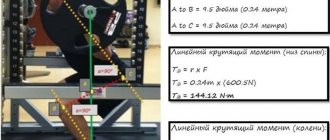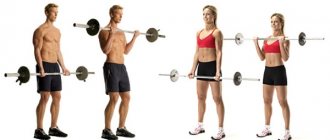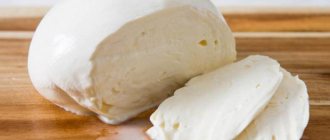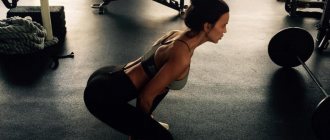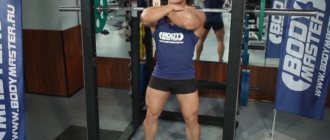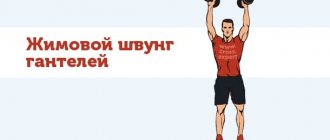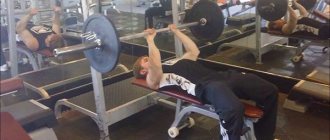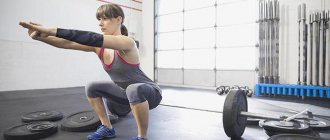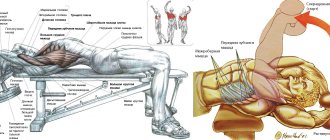1. Repetitions
When you're squatting to build muscle, a standard rep range of 8-12 works very well. However, patterns of 25-50 reps per set can also help build muscle. And there are several arguments in favor of this:
- A mixture of different types of muscle fibers in your legs.
- The volume of blood entering the muscles, with a large number of repetitions, stimulates the pump effect (always a useful thing).
- High reps stimulate the production of growth hormone, which is essential for building muscle and burning fat.
If you look at most powerlifters and strength athletes, most of them do between 1 and 5 reps per set. Five is a great number for strength and will also help add size, but if you're a pure strength builder and don't want your legs to add much size, stick to 1-3 reps.
6. Body tilt
When you want to work your leg muscles, you try to bend over as little as possible. The closer the body is to a vertical position, the greater the load on the legs. The greater the inclination, the more your back works.
This is why front squats develop the quadriceps so effectively - the body is vertical and the legs work to their full potential. Among lifters, I have seen a variety of options and degrees of inclination, it depends on the individual. The main thing is to lower the pelvis to the desired depth, and everyone chooses the position of the body that is most convenient for themselves.
2. Weight on the projectile
The point of results in bodybuilding is that no one judges how much an athlete can lift, they look at what their muscles look like. Of course, you want to lift your weight as high as possible, but what matters is the appearance of your muscles. You use the amount of weight you need to perform a certain number of repetitions and put enough stress on your muscles, which subsequently allows you to increase their size. What and how much you lift matters, but what matters more is how you lift the weight. Slow tempo bodybuilding squats with a 3-1-X-1 tempo (see paragraph #3) can more than give your legs the workout they need without using tons of weight on the bar. In powerlifting, the weight on the machine is all that matters. You are not trying to isolate or build muscle. The goal is to squat with as much weight as possible, reach the required squat depth, and stand up, that's it.
5. Neck position
In the back squat, the bar can be positioned higher or lower. In its lowest position it is located near the shoulder blades, in its highest position it is on the upper part of the trapezius.
Typically bodybuilders squat with a high bar position because it places the center of gravity over the hips.
Powerlifters do different variations of the squat, but the vast majority prefer a low bar position to shorten the range of motion and transfer the load to the entire pelvic girdle, not just the quads.
3. Tempo of repetitions
Another important factor when lifting weights is tempo. Let's say you're comfortable with the 4-1-X-1 tempo. The first number is the duration of the negative phase (in this case, lowering the weight). Therefore, 4 means a 4-second negative phase. The second number is the pause between lowering and raising. In the case of squats, the pause occurs at the bottom of the amplitude (squat) and lasts 1 second. The third number indicates the concentric or explosive phase of lifting the weight. Here we use X to mean "as quickly as possible." The last number is the pause at the top of the repeat. This may be an additional contraction (squeeze) at the top of the movement, or it may be a standard rest pause, depending on your goals. In our example, we use a 1 second pause. Let's look at each stage.
Negative Phase
Using “tempo” works very well within the bodybuilding/hypertrophy target framework. The negative phase of the repetition is very important for muscle development (plus), but it is also very unpleasant, as it causes significant pain and discomfort to the muscles (minus). Muscle soreness isn't such a bad thing if you squat once a week, but most powerlifters squat two to four times a week, so they can't afford to have constant pain in the muscle group they're training.
Pause Phase
Pauses are useful in both bodybuilding and powerlifting squats. For bodybuilders, the pause phase is a great way to further stretch a muscle and improve the possible range of contraction of that muscle. For a powerlifter, pausing at the bottom can make you stronger as you “climb out of the hole” at the bottom of the squat. This pause is especially useful for deep, heavy squats.
Concentric Phase
Controlled lowering is beneficial for hypertrophy. When it comes to powerlifting, there is no need to focus on the slow negative phases or tempo of the reps, since you always perform reps at the same speed in powerlifting - as fast as possible. When you squat with a lot of weight, you can't squat fast visually, but the main thing is to try to squat as quickly as possible. So, performing a concentrated negative phase is not as important for powerlifting as it is for bodybuilding.
Table of physical education standards for schoolchildren 2020-2021 (physical education)
Nowadays, society does not attach due importance to physical education lessons at school. Some people think that at school there is nothing interesting or useful in physical education lessons and it is better for the child to do additional lessons, while others are simply lazy and he/she does not go to these lessons out of principle. An even more frightening trend is the fact that the promotion of a lifestyle in which sports plays an important and fundamental role has come to almost nothing in our country. That is why it is necessary to understand and realize the usefulness of physical education lessons at school.
Approximate standards from grades 1 to 11
Physical education standards for 1st grade
| Exercises | Boys | Girls | |||||
| 5 | 4 | 3 | 5 | 4 | 3 | ||
| Run 30 m (sec) | 6,1 | 6,9 | 7,0 | 6.6 | 7,4 | 7,5 | |
| “Shuttle run” 3x10 m (sec.) | 9.9 | 10.8 | 11,2 | 10.2 | 11,3 | 11,7 | |
| Skiing 1 km. | 8.30 | 9,00 | 9,30 | 9.00 | 9,30 | 10,0 | |
| Cross 1000 m (min.,sec.) | no time | no time | |||||
| Standing long jump (cm) | 140 | 115 | 100 | 130 | 110 | 90 | |
| Medicine ball throw (cm) | 295 | 235 | 195 | 245 | 220 | 200 | |
| Throwing a small ball 150g (m) | 20 | 15 | 10 | 15 | 10 | 5 | |
| Throwing at a target from 6 m | 3 | 2 | 1 | 3 | 2 | 1 | |
| Jumping rope in 1 minute. | 40 | 30 | 15 | 50 | 30 | 20 | |
| Raising the body in 1 minute. | 30 | 26 | 18 | 18 | 15 | 13 | |
| Hanging pull-up (one time) | 4 | 2 | 1 | ||||
| Pull-ups while lying down (one time) | 12 | 8 | 2 | ||||
| Seated forward bend (cm) | 9 | 3 | 1 | 12,5 | 6 | 2 | |
Physical education standards for grade 2
| Exercises 2nd grade, approximate standards | Boys | Girls | ||||
| 5 | 4 | 3 | 5 | 4 | 3 | |
| Shuttle run 4×9 m, sec | 12,0 | 12,8 | 13,2 | 12,4 | 12,8 | 13,2 |
| Shuttle run 3×10 m, sec | 9,1 | 10,0 | 10,4 | 9,7 | 10,7 | 11,2 |
| Run 30 m, s | 5,4 | 7,0 | 7,1 | 5,6 | 7,2 | 7,3 |
| Running 1,000 meters | without time | |||||
| Standing long jump, cm | 165 | 125 | 110 | 155 | 125 | 100 |
| High jump method of stepping, cm | 80 | 75 | 70 | 70 | 65 | 60 |
| Jumping rope (number of times/min.) | 70 | 60 | 50 | 80 | 70 | 60 |
| Pull-up on the bar | 4 | 2 | 1 | |||
| Raising the body from a supine position (number of times/min) | 23 | 21 | 19 | 28 | 26 | 24 |
| Squats (number of times/min) | 40 | 38 | 36 | 38 | 36 | 34 |
| Multi-jump – 8 m jumps. | 12 | 10 | 8 | 12 | 10 | 8 |
Physical education standards for grade 3
| Exercises 3rd grade, approximate standards | Boys | Girls | ||||
| 5 | 4 | 3 | 5 | 4 | 3 | |
| Shuttle run 3×10 m, sec | 8,8 | 9,9 | 10,2 | 9,3 | 10,3 | 10,8 |
| Run 30 m, s | 5,1 | 6,7 | 6,8 | 5,3 | 6,7 | 7,0 |
| Running 1,000 meters | without time | |||||
| Standing long jump, cm | 160 | 130 | 120 | 160 | 135 | 110 |
| High jump method of stepping, cm | 85 | 80 | 75 | 75 | 70 | 65 |
| Jumping rope (number of times/min.) | 80 | 70 | 60 | 90 | 80 | 70 |
| Pull-up on the bar | 5 | 3 | 1 | |||
| Tennis ball throws, m | 18 | 15 | 12 | 15 | 12 | 10 |
| Raising the body from a supine position (number of times/min) | 25 | 23 | 21 | 30 | 28 | 26 |
| Squats (number of times/min) | 42 | 40 | 38 | 40 | 38 | 36 |
| Multi-jump – 8 m jumps. | 13 | 11 | 9 | 13 | 11 | 9 |
| Pistols, supported on one hand, on the right and left leg (number of times). (m) | 6 | 4 | 2 | 5 | 3 | 1 |
Physical education standards for grade 4
| Exercises 4th grade, approximate standards | Boys | Girls | ||||
| 5 | 4 | 3 | 5 | 4 | 3 | |
| Shuttle run 3×10 m, sec | 8,6 | 9,5 | 9,9 | 9,1 | 10,0 | 10,4 |
| Run 30 m, s | 5,0 | 6,5 | 6,6 | 5,2 | 6,5 | 6,6 |
| Run 1,000 meters, min | 5,50 | 6,10 | 6,50 | 6,10 | 6,30 | 6,50 |
| Standing long jump, cm | 185 | 140 | 130 | 170 | 140 | 120 |
| High jump method of stepping, cm | 90 | 85 | 80 | 80 | 75 | 70 |
| Jumping rope (number of times/min.) | 90 | 80 | 70 | 100 | 90 | 80 |
| Pull-up on the bar | 5 | 3 | 1 | |||
| Tennis ball throwing, m | 21 | 18 | 15 | 18 | 15 | 12 |
| Raising the body from a supine position (number of times/min) | 28 | 25 | 23 | 33 | 30 | 28 |
| Squats (number of times/min) | 44 | 42 | 40 | 42 | 40 | 38 |
| Multi-jump – 8 m jumps. | 15 | 14 | 13 | 14 | 13 | 12 |
| Pistols, supported on one hand, on the right and left leg (number of times). (m) | 7 | 5 | 3 | 6 | 4 | 2 |
Physical education standards for grade 5
| Exercises, 5th grade | Boys | Girls | ||||
| 5 | 4 | 3 | 5 | 4 | 3 | |
| Shuttle run 4×9 m, sec | 10,2 | 10,7 | 11,3 | 10,5 | 11,0 | 11,7 |
| Run 30 m, s | 5,5 | 6,0 | 6,5 | 5,7 | 6,2 | 6,7 |
| Run 60 m, s | 10,0 | 10,6 | 11,2 | 10,4 | 10,8 | 11,4 |
| Run 300 m, min, s | 1,02 | 1,06 | 1,12 | 1,05 | 1,10 | 1,15 |
| Run 1000 m, min, s | 4,30 | 4,50 | 5,20 | 4,50 | 5,10 | 5,40 |
| Run 2000 m | No time tracking | |||||
| Cross 1.5 km, min, s | 8,50 | 9,30 | 10,0 | 9,00 | 9,40 | 10,30 |
| Hanging pull-up on the bar, one time | 7 | 5 | 3 | |||
| Pull-up on a low bar from a hanging position, one time | 15 | 10 | 8 | |||
| Flexion and extension of the arms while lying down | 17 | 12 | 7 | 12 | 8 | 3 |
| Raising the body from a supine position, arms crossed on the chest in 1 minute, once | 39 | 33 | 27 | 28 | 23 | 20 |
| Standing long jump, cm | 170 | 160 | 140 | 160 | 150 | 130 |
| Running long jump, cm | 340 | 300 | 260 | 300 | 260 | 220 |
| Running high jump, cm | 110 | 100 | 85 | 105 | 95 | 80 |
| Skiing 1 km, min, sec | 6,30 | 7,00 | 7,40 | 7,00 | 7,30 | 8,10 |
| Skiing 2 km, min, sec | No time tracking | |||||
| Ski technique | |||||
| Dribbling the ball while running in basketball | Technique | |||||
| Jumping rope in 1 minute | 70 | 60 | 55 | 60 | 50 | 30 |
| Jump rope, 15 sec, times | 34 | 32 | 30 | 38 | 36 | 34 |
| Swimming without time, m | 50 | 25 | 12 | 25 | 20 | 12 |
Physical education standards for 6th grade
| Exercises, 6th grade | Boys | Girls | ||||
| 5 | 4 | 3 | 5 | 4 | 3 | |
| Shuttle run 4×9 m, sec | 10,0 | 10,5 | 11,5 | 10,3 | 10,7 | 11,5 |
| Run 30 m, s | 5,5 | 5,8 | 6,2 | 5,8 | 6,1 | 6,5 |
| Run 60 m, s | 9,8 | 10,2 | 11,1 | 10,0 | 10,7 | 11,3 |
| Run 500 meters, min | 2,22 | 2,55 | 3,20 | |||
| Run 1,000 meters, min | 4,20 | 4,45 | 5,15 | |||
| Running 2,000 meters | no time | |||||
| Cross-country skiing 2 km, min | 13,30 | 14,00 | 14,30 | 14,00 | 14,30 | 15,00 |
| Cross-country skiing 3 km, min | 19,00 | 20,00 | 22,00 | |||
| Standing long jump, cm | 175 | 165 | 145 | 165 | 155 | 140 |
| Pull-up on the bar | 8 | 6 | 4 | |||
| Lying push-ups | 20 | 15 | 10 | 15 | 10 | 5 |
| Bend forward from a sitting position | 10 | 6 | 3 | 14 | 11 | 8 |
| Raising the body in 1 minute from a lying position (press), times | 40 | 35 | 25 | 35 | 30 | 20 |
| Jumping rope in 20 seconds | 46 | 44 | 42 | 48 | 46 | 44 |
Physical education standards for 7th grade
| Exercises, 7th grade | Boys | Girls | ||||
| 5 | 4 | 3 | 5 | 4 | 3 | |
| Shuttle run 4×9 m, sec | 9,8 | 10,3 | 10,8 | 10,1 | 10,5 | 11,3 |
| Run 30 m, s | 5,0 | 5,3 | 5,6 | 5,3 | 5,6 | 6,0 |
| Run 60 m, s | 9,4 | 10,0 | 10,8 | 9,8 | 10,4 | 11,2 |
| Run 500 meters, min | 2,15 | 2,25 | 2,40 | |||
| Run 1,000 meters, min | 4,10 | 4,30 | 5,00 | |||
| Run 2,000 meters, min | 9,30 | 10,15 | 11,15 | 11,00 | 12,40 | 13,50 |
| Cross-country skiing 2 km, min | 12,30 | 13,30 | 14,00 | 13,30 | 14,00 | 15,00 |
| Cross-country skiing 3 km, min | 18,00 | 19,00 | 20,00 | 20,00 | 25,00 | 28,00 |
| Standing long jump, cm | 180 | 170 | 150 | 170 | 160 | 145 |
| Pull-up on the bar | 9 | 7 | 5 | |||
| Lying push-ups | 23 | 18 | 13 | 18 | 12 | 8 |
| Bend forward from a sitting position | 11 | 7 | 4 | 16 | 13 | 9 |
| Raising the body in 1 minute from a lying position (press), times | 45 | 40 | 35 | 38 | 33 | 25 |
| Jumping rope in 20 seconds | 46 | 44 | 42 | 52 | 50 | 48 |
Physical education standards for 8th grade
| Exercises, 8th grade | Boys | Girls | ||||
| 5 | 4 | 3 | 5 | 4 | 3 | |
| Shuttle run 4×9 m, sec | 9,6 | 10,1 | 10,6 | 10,0 | 10,4 | 11,2 |
| Run 30 m, s | 4,8 | 5,1 | 5,4 | 5,1 | 5,6 | 6,0 |
| Run 60 m, s | 9,0 | 9,7 | 10,5 | 9,7 | 10,4 | 10,8 |
| Run 1,000 meters, min | 3,50 | 4,20 | 4,50 | 4,20 | 4,50 | 5,15 |
| Run 2,000 meters, min | 9,00 | 9,45 | 10,30 | 10,50 | 12,30 | 13,20 |
| Cross-country skiing 3 km, min | 16,00 | 17,00 | 18,00 | 19,30 | 20,30 | 22,30 |
| Cross-country skiing 5 km, min | without time | |||||
| Standing long jump, cm | 190 | 180 | 165 | 175 | 165 | 156 |
| Pull-up on the bar | 10 | 8 | 5 | |||
| Lying push-ups | 25 | 20 | 15 | 19 | 13 | 9 |
| Bend forward from a sitting position | 12 | 8 | 5 | 18 | 15 | 10 |
| Raising the body in 1 minute from a lying position (press), times | 48 | 43 | 38 | 38 | 33 | 25 |
| Jumping rope in 25 seconds | 56 | 54 | 52 | 62 | 60 | 58 |
Standards for physical education for 9th grade
| Exercises, 9th grade | Boys | Girls | ||||
| 5 | 4 | 3 | 5 | 4 | 3 | |
| Shuttle run 4×9 m, sec | 9,4 | 9,9 | 10,4 | 9,8 | 10,2 | 11,0 |
| Run 30 m, s | 4,6 | 4,9 | 5,3 | 5,0 | 5,5 | 5,9 |
| Run 60 m, s | 8,5 | 9,2 | 10,0 | 9,4 | 10,0 | 10,5 |
| Run 2,000 meters, min | 8,20 | 9,20 | 9,45 | 10,00 | 11,20 | 12,05 |
| Cross-country skiing 1 km, min | 4,30 | 4,50 | 5,20 | 5,45 | 6,15 | 7,00 |
| Cross-country skiing 2 km, min | 10,20 | 10,40 | 11,10 | 12,00 | 12,45 | 13,30 |
| Cross-country skiing 3 km, min | 15,30 | 16,00 | 17,00 | 19,00 | 20,00 | 21,30 |
| Cross-country skiing 5 km, min | without time | |||||
| Standing long jump, cm | 210 | 200 | 180 | 180 | 170 | 155 |
| Pull-up on the bar | 11 | 9 | 6 | |||
| Lying push-ups | 32 | 27 | 22 | 20 | 15 | 10 |
| Bend forward from a sitting position | 13 | 11 | 6 | 20 | 15 | 13 |
| Raising the body in 1 minute from a lying position (press), times | 50 | 45 | 35 | 40 | 35 | 26 |
| Jumping rope in 25 seconds | 58 | 56 | 54 | 66 | 64 | 62 |
Physical education standards for grade 10
| Exercises, 10th grade | Boys | Girls | ||||
| 5 | 4 | 3 | 5 | 4 | 3 | |
| Shuttle run 4×9 m, sec | 9,3 | 9,7 | 10,2 | 9,7 | 10,1 | 10,8 |
| Run 30 m, s | 4,7 | 5,2 | 5,7 | 5,4 | 5,8 | 6,2 |
| Run 100 m, s | 14,4 | 14,8 | 15,5 | 16,5 | 17,2 | 18,2 |
| Run 2 km, min | 10,20 | 11,15 | 12,10 | |||
| Running 3 km meters, min | 12,40 | 13,30 | 14,30 | |||
| Cross-country skiing 1 km, min | 4,40 | 5,00 | 5,30 | 6,00 | 6,30 | 7,10 |
| Cross-country skiing 2 km, min | 10,30 | 10,50 | 11,20 | 12,15 | 13,00 | 13,40 |
| Cross-country skiing 3 km, min | 14,40 | 15,10 | 16,00 | 18,30 | 19,30 | 21,00 |
| Cross-country skiing 5 km, min | 26,00 | 27,00 | 29,00 | without time | ||
| Standing long jump, cm | 220 | 210 | 190 | 185 | 170 | 160 |
| Pull-up on the bar | 12 | 10 | 7 | |||
| Lifting upside down on a high bar | 3 | 2 | 1 | |||
| Lying push-ups | 32 | 27 | 22 | 20 | 15 | 10 |
| Bending and extension of the arms in support on the uneven bars, once | 10 | 7 | 4 | |||
| Rope climbing without legs, m | 5 | 4 | 3 | |||
| Bend forward from a sitting position | 14 | 12 | 7 | 22 | 18 | 13 |
| Raising the body in 1 minute from a lying position (press), times | 50 | 40 | 35 | 40 | 35 | 30 |
| Jumping rope in 25 seconds | 65 | 60 | 50 | 75 | 70 | 60 |
Standards for physical education for 11th grade
| Exercises, 11th grade | Boys | Girls | ||||
| 5 | 4 | 3 | 5 | 4 | 3 | |
| Shuttle run 4×9 m, sec | 9,2 | 9,6 | 10,1 | 9,8 | 10,2 | 11,0 |
| Run 30 m, s | 4,4 | 4,7 | 5,1 | 5,0 | 5,3 | 5,7 |
| Run 100 m, s | 13,8 | 14,2 | 15,0 | 16,2 | 17,0 | 18,0 |
| Run 2 km, min | 10,00 | 11,10 | 12,20 | |||
| Running 3 km meters, min | 12,20 | 13,00 | 14,00 | |||
| Cross-country skiing 1 km, min | 4,30 | 4,50 | 5,20 | 5,45 | 6,15 | 7,00 |
| Cross-country skiing 2 km, min | 10,20 | 10,40 | 11,10 | 12,00 | 12,45 | 13,30 |
| Cross-country skiing 3 km, min | 14,30 | 15,00 | 15,50 | 18,00 | 19,00 | 20,00 |
| Cross-country skiing 5 km, min | 25,00 | 26,00 | 28,00 | without time | ||
| Cross-country skiing 10 km, min | without time | |||||
| Standing long jump, cm | 230 | 220 | 200 | 185 | 170 | 155 |
| Pull-up on the bar | 14 | 11 | 8 | |||
| Lifting upside down on a high bar | 4 | 3 | 2 | |||
| Lying push-ups | 32 | 27 | 22 | 20 | 15 | 10 |
| Bend forward from a sitting position, cm | 15 | 13 | 8 | 24 | 20 | 13 |
| Bending and extension of the arms in support on the uneven bars, once | 12 | 10 | 7 | |||
| Bend forward from a sitting position | 14 | 12 | 7 | 22 | 18 | 13 |
| Raising the body in 1 minute from a lying position (press), times | 50 | 45 | 40 | 42 | 36 | 30 |
| Jumping rope in 30 seconds | 70 | 65 | 55 | 80 | 75 | 65 |
| Jumping rope in 60 seconds | 130 | 125 | 120 | 133 | 110 | 70 |
Many parents believe that physical education teachers at school are people who have nothing to do with sports or sports education. It is immediately important to note that this statement is fundamentally not true. First of all, it is necessary to realize that these days, without being a professional athlete in the past or a person with a sports education, it is almost impossible to get a job at a school as a physical education teacher. This fact indicates that all those children who will engage in physical education at school under the supervision of a specialist practitioner or theorist (depending on the type of previous activity of the teacher) will at least be able to achieve good results in certain sports disciplines, if they want to. .
It is very important that people who attend physical education classes develop motivational qualities in themselves. If we compare in everyday life people who paid attention to sports and those who never wore a tracksuit, then the difference in life motivation is visible to the naked eye. People involved in physical education, and therefore the majority of those who attend physical education classes at school, are much more successful, since even during their school years, in physical education lessons, they develop such qualities as determination and overcoming oneself.
According to statistics, those who do not attend physical education classes on a regular basis get sick twice as often during flu epidemics as those who regularly attend physical education classes. As a result, those who get sick more often have a large number of problems with academic performance, due to the fact that they attend fewer classes at school. It would seem that skipping classes at school and not wanting to attend physical education classes are in no way connected at first glance. However, if you trace the cause-and-effect relationship described above, it becomes clear why it is so important to go to physical education classes and not look for excuses for yourself to once again sit on the bench while your classmates are taking tests or just playing sport games.
If all of the above arguments are not convincing enough, then a small experiment should be conducted. The student needs to compare his well-being over two months. Let him not go to sports at school for one month and sit on the bench. In another month, you must attend all physical education lessons and follow all the teacher’s instructions. Each day of these two days it is necessary to leave an entry in a special diary, in which the student will leave his impressions of his well-being and general condition of the body. After two months, re-read the diary and compare your entries. Surely the conclusions will be amazing for many, but what they will be can be found out by conducting this experiment.
Of course, it is quite difficult to call modern school physical education perfect. And there are many reasons for this. But if you approach this lesson more carefully, consider what the teachers offer, and do not try to evade and hide somewhere in the alley, then in the future you will be able to express huge gratitude to the teachers for this.
Now let’s move away from loud phrases and try to figure out what the real benefits of being in the gym or on the sports ground are. First of all, it's a matter of physiology. A growing young body requires mobility in order to be able to circulate blood throughout the body. This is why children tear down ceilings in hallways or classrooms during recess. And the more you try to keep them under strict discipline, the louder they will scream at recess.
Physical education classes are designed to balance this imbalance. A properly constructed physical warm-up allows you to disperse excess energy throughout the body. In this case, there is no overwork, as well as the danger of getting a sprain or other kind of injury. Moreover, thanks to active physical exercises, the body is morally recharged, when the brain temporarily switches off complex mathematical calculations or thoughts about a literary plot, giving a person the opportunity to refresh his thoughts. In the future, this helps you cope with complex tasks that were left for last.
Among other things, physical education sometimes allows a person to reveal hidden talents that in another environment he would simply be embarrassed to reveal. After all, here, in essence, everyone is equal and everyone is in equal conditions, when few people will joke about your successes. But an experienced teacher will be able to assess the possible potential and develop it in the future. This is exactly how future football players, volleyball players, basketball players, and track and field athletes manifest themselves. After visiting the gym, many people want to develop independently, improve their body and improve their health. And this is precisely what is valuable in school physical education, as a source of limitless opportunities in the future.
Barbell squats - technical rules and execution procedure
- After removing the bar from the racks (assistants on the platform can assist the athlete in removing the bar), the athlete, moving backward, stands in the original starting position facing the front of the platform. In this case, the bar of the bar should lie horizontally on the athlete’s shoulders, the fingers clasp the bar, and the top of the bar should be no lower than the thickness of the bar itself from the top of the outer parts of the shoulders. The hands can be placed on the bar anywhere between the bushings, until they touch their inner side.
- Once the lifter has assumed a stationary position with the legs straightened at the knees and the torso vertical, and the barbell is in the correct position, the head referee must give the signal to begin the exercise. The signal is a downward movement of the hand along with a clear command to “squat” (“squat”). Before receiving the signal to start the exercise, the athlete is allowed to make any movements that do not entail a violation of the rules to take the starting position. For safety reasons, the referee may ask the lifter to return the barbell to the racks by giving a clear command to “replace” with a simultaneous movement of the arm backwards if, within five seconds of removing the barbell from the racks, he has not been able to assume the correct starting position to begin the lift. .
- Having received the signal from the head judge to begin the exercise, the athlete must bend his knees and lower his torso so that the top of the legs at the hip joints is lower than the top of the knees. Only one attempt to make a downward movement is allowed. An attempt is considered valid if the athlete's knees are bent. During the exercise, the bar may move from the starting position down along the athlete’s back, but no more than by the thickness (diameter) of the bar itself.
- The athlete must independently return to a vertical position with legs fully straightened at the knees. Double rising (jumping) from the bottom of a squat or any downward movement is prohibited. When the lifter, having completed the movement, assumes a stationary position, the senior referee must give the signal to return the bar to the racks.
- The signal to return the bar to the racks consists of a backward movement of the arm and a distinct command to “rack.” Then the athlete must move forward and return the bar to the racks. For safety reasons, the athlete can ask assistants for help returning the barbell to the racks. In this case, the barbell must remain on the athlete’s shoulders.
- While performing a squat, there should be no more than 5 and no less than 2 spotters (assistants) on the platform. The judges can decide what number of assistants - 2,3,4 or 5 - should be on the platform during all these stages of the exercise.
Reasons why the weight lifted in a squat does not count
- Failure to comply with the senior referee's signals when starting or finishing an exercise.
- Double stand-up (jump) from the bottom of a squat position or any downward movement while standing up.
- Error in taking a vertical position with legs fully straightened at the knees at the beginning or end of the exercise.
- Stepping backwards or forwards, although lateral horizontal movement of the sole and rocking of the feet between the toe and heel are permitted.
- An error in bending the legs at the knees and lowering the body to a position where the upper surface of the legs at the hip joints is lower than the tops of the knees
- Any movement of the bar from the starting position down along the athlete’s back by more than the thickness (diameter) of the bar itself during the exercise.
- Touching the bar or the athlete by spotters (assistants) between the signals of the senior judge to facilitate the execution of the squat.
- Touching legs with elbows or shoulders; A light touch is allowed if it does not help lift the barbell.
- Any throwing or dropping of the barbell onto the platform after completing a squat.
- Failure to comply with any of the requirements contained in the description of the squat rules.
